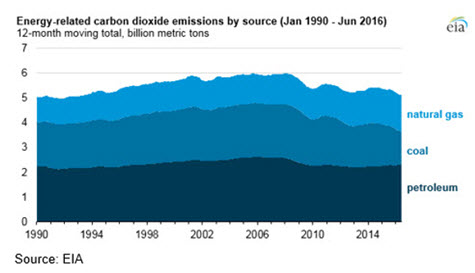WASHINGTON, Oct. 20, 2016 - In the first six months of 2016, energy-related carbon dioxide (CO2) emissions in the U.S. totaled 2,530 million metric tons, the lowest emissions level for the first six months of the year since 1991, according to new data from the Energy Information Administration (EIA).
EIA attributes the decline to mild weather, as well as changes in the fuel mix used to generate electricity.
In the first six months of 2016, the agency says the U.S. had the fewest heating degree days since at least 1949, with warmer weather reducing the demand for heating fuels such as natural gas, distillate heating oil and electricity.
EIA’s data show that total primary energy consumption was 2 percent lower compared with the first six months of 2015.
Most notable was the decline in the residential and electric power sectors, EIA says, where primary energy consumption decreased 9 percent and 3 percent, respectively.
Coal and natural gas consumption each decreased compared to the first six months of 2015, the agency says, noting that the decrease was greater for coal, which generates more carbon emissions when burned than natural gas.
Coal consumption fell 18 percent, the data show, while
natural gas consumption declined 1 percent. These declines “more than offset” a
1 percent increase in total petroleum consumption, which rose during that
period as a result of low gasoline prices.
The consumption of renewable fuels, which do not produce carbon dioxide, increased 9 percent during the first six months of 2016 compared with the same period in 2015, with wind energy seeing the largest electricity generating capacity additions of any fuel in 2015 and accounting for nearly half the increase.
Do you find the information on Agri-Pulse helpful? See even more ag, rural policy and energy news when you sign up for a four-week free trial Agri-Pulse subscription.
Hydroelectric power, which has increased with the easing of drought conditions on the West Coast, accounted for 35 percent.
EIA forecasts that solar energy, which accounted for 13 percent of the increase in renewable fuels use, will see the largest capacity additions of any fuel in 2016.
EIA’s Short-Term Energy Outlook also projects that energy-associated CO2 emissions will fall to 5,179 million metric tons in 2016, the lowest annual level since 1992.
#30
For more news, go to: www.Agri-Pulse.com
